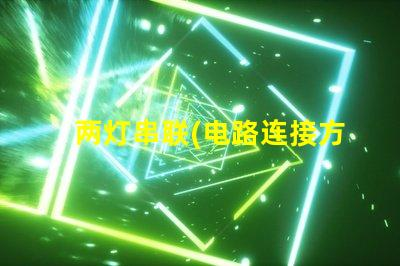Second-class series (circuit connection analysis) of the operation guide, summarized to everyone today, I hope to help you.
In circuit connection, there are many ways to connect electrical equipment, one of which is to connect two lamps in series. This paper attempts to discuss the way of connecting two lamps in series, and discuss its characteristics and usage.
1: What is double lights connected in series?

Second-class series connection refers to connecting two bulbs together in a certain connection mode to share the current and voltage of the circuit. This connection is often used for home lighting, office lighting, etc.
The positive and negative poles of the two bulbs can be connected in series to form a closed circuit. In this way, the current can pass through the bulb from the power supply and then return to the power supply through another bulb. This connection can make two bulbs emit light at the same time, increasing the brightness of the light.
Second: the characteristics of second-class series connection
The second-class series connection mode has the following characteristics:
1. Bulb brightness limit: Because the two bulbs are connected in series, the current passes through the two bulbs, and the current received by each bulb is small, so the bulb brightness is relatively low.
2. Impact of bulb failure: When one bulb fails, the whole circuit is interrupted because two bulbs are connected in series, resulting in other bulbs not working. Therefore, in the circuit where two lights are connected in series, the failure of one bulb will affect the normal operation of the whole circuit.
3. Power supply voltage requirements: The circuit connecting two electric lamps in series should provide enough voltage to drive two bulbs. Therefore, the voltage of the power supply should meet the working voltage requirements of the two bulbs.
Third: second-class series use method
In practical application, the way of connecting two lamps in series is often used for home lighting, office lighting and so on. The following is the usage of second-class tandem.
1. Choose the right bulb: When two lamps are connected in series, two bulbs with the same parameters should be selected to ensure that they can share the current and voltage of the circuit. If the parameters of the two bulbs are different, the brightness of one bulb may be higher and the brightness of the other bulb may be lower.
2. Connection circuit: Connect the positive and negative poles of the two bulbs to form a closed circuit. Check whether the connection is correct to avoid short circuit and overcurrent.
3. Provide enough voltage: The circuit with two electric lamps in series must provide enough voltage to drive the two bulbs. Therefore, the appropriate power supply and battery must be selected.
Fourth: Advantages and disadvantages of second-class series connection
Second-class series connection has the following advantages and disadvantages:
Advantages:
1. Easy to understand: The way of connecting two lamps in series is relatively simple, and complicated circuit design and connection method are not needed.
2. Low cost: The way of connecting two lamps in series does not need additional circuit components, so the cost is relatively low.
Disadvantages:
1. Brightness limit: Because two bulbs are connected in series, the current received by each bulb is small, resulting in relatively low bulb brightness.
2. Fault effect: If one bulb fails, the whole circuit will be interrupted, resulting in other bulbs not working. 5: Second-class tandem application scenario
The way of connecting two lamps in series is often used for home lighting and office lighting. This connection can make two bulbs emit light at the same time by sharing the current and voltage of the circuit, thus improving the brightness of the light. The way of connecting two lamps in series is easy to understand and low in cost, which is suitable for some simple lighting requirements.
This is the end of the solution to the second-class series connection (analysis of circuit connection mode). I hope I can help. How is it? Learn more about the suggestions.
Two electric lamps in series is a common circuit connection mode. By connecting two bulbs together in a certain connection mode, the current and voltage in the circuit are shared. This connection mode has the characteristics of bulb brightness limitation, bulb fault influence, power supply voltage requirement and so on. In practical application, two lamps in series are often used for home lighting, office lighting, etc., which has the advantages of easy to understand and low cost. However, due to the limitation of brightness and the influence of faults, it is necessary to choose the appropriate connection mode according to specific requirements.
LEDSMDBEADS
release time:2023-10-30 16:29:57
Reading volume:1

